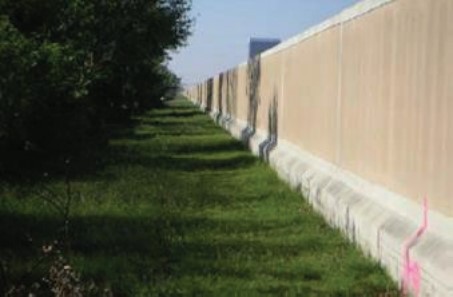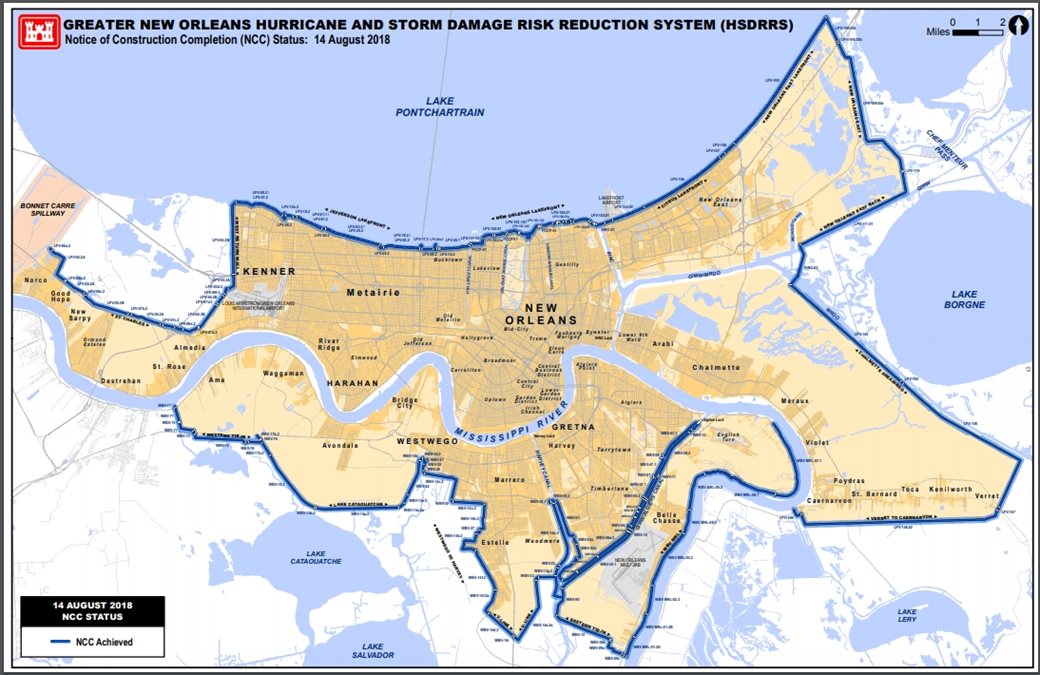Definition
Levees play a vital role in protecting New Orleans from coastal and riverine floods.
Man-made levees can fail in a number of ways. The most frequent (and dangerous) form of levee failure is a breach. A levee breach is when part of the levee actually breaks away, leaving a large opening for water to flood the land protected by the levee. A breach can be a sudden or gradual failure that is caused either by surface erosion or by a subsurface failure of the levee. Levee breaches are often accompanied by levee boils or sand boils.
A sand boil occurs when the upward pressure of water flowing through soil pores under the levee (under seepage) exceeds the downward pressure from the weight of the soil above it. The under seepage resurfaces on the landside in the form of a volcano-like cone of sand. Boils signal a condition of incipient instability, which may lead to erosion of the levee toe or foundation or result in the sinking of the levee into the liquefied foundation below. Complete breach of the levee may quickly follow.
Levee overtopping occurs when water overtops the crest of the levee. Levee overtopping can be caused when floodwaters simply exceed the lowest crest of the levee system or if high winds begin to generate significant swells in the ocean or river water to bring waves crashing over the levee.
New Orleans Levee System
Some background about how New Orleans was founded and expanded will help explain the City’s levee system. New Orleans was founded by the French in 1718 at the natural levee embankment on a tight outer bend of the lower Mississippi River. After the Louisiana Settlement of 1803, the town quickly became the largest U.S. city in the South, expanding its footprint along the flanks of the levees as they followed the meandering river east and west to become the Crescent City. Undeveloped marshland areas remained north of the City.
Developers in the 19th century, interested in expanding the City to the north, recognized that pumps would be required to keep the marshland areas from flooding. In 1928 a 14-foot electricity-powered screw siphon pump was developed by a City of New Orleans engineer to remove floodwater from the City. Increases in pumping capacity at the beginning of the 20th Century saw the city expand across the swamplands right up to the lake’s shore. From 1900 through 1930, the population of Orleans Parish grew over 60 percent, to 460,000 people. As described in detail in the Storm Surge subsection (Section xx), a series of drainage canals were also constructed around this time to convey stormwater from the City into Lake Pontchartrain.
The majority of the perimeter floodwall and levee system was designed and constructed after Hurricane Betsy in 1965. The flood protection system was built to withstand an event roughly equivalent to a typical Category 3 hurricane.
Figure 48: Typical Floodwall Construction along the 17th Street Canal in New Orleans

Source: Preliminary Report on the Performance of the New Orleans Levee Systems in Hurricane Katrina on August 29, 2005
The levee system protecting New Orleans consists of over 350 miles of levees, which 133 miles have been newly strengthened after Hurricane Katrina. Much of the system protecting the New Orleans region has been constructed with a combination of earthen and concrete materials, including the following
- Sheet Pile – A row of piles driven side-by-side to retain the earth or prevent seepage.
- Concrete I-Walls – Concrete floodwalls are mainly “I-walls” with the concrete wall section cast atop a row of sheet piles driven through the crest of an earthen embankment.
- Concrete T-Walls – These wall sections also cap a sheet pile curtain, but they get additional rotational and lateral stability by nature of their broad concrete base (which forms an inverted “T”).
- Earthen levee – A low ridge of an earthen embankment built along the edges of a stream or river channel to prevent flooding of the adjacent land.
The City of New Orleans is currently protected from storm surge flooding by a complex network of levee systems. There are three USACE levee systems in New Orleans and the surrounding area: The Lake Pontchartrain and Vicinity, the West Bank and Vicinity, and the New Orleans to Venice hurricane protection projects, which are collectively known as the Hurricane & Storm Damage Risk Reduction System (HSDRRS).[1]
The primary system of flood defense in New Orleans is the Lake Pontchartrain and Vicinity project, which covers St. Bernard, Orleans, Jefferson, and St. Charles parishes, generally between Lake Pontchartrain and the Mississippi River. It also includes flood defenses around the 17th Street, Orleans Avenue, London Avenue, and Industrial canals, as well as the Inner Harbor Navigation Canal (IHNC).
A portion of the Lake Pontchartrain and Vicinity Levee system, also known as the New Orleans Flood Protection System, can be further broken down into a series of protected basins or “polders,” each protected by its own perimeter levee system. The New Orleans Flood Protection System is also supported by a series of pumps to remove surface runoff from within the City. There are four main polders (or protected units) that comprise the City of New Orleans flood protection system. The four polders include the following
- Orleans East Bank
- New Orleans East
- St. Bernard Parish - Contains the Lower Ninth Ward and St. Bernard Parish
- Plaquemines Parish Protection Zone
Three of the four polders are described in detail below. The Plaquemines Parish Protection zone contains a thin protected strip along the Mississippi River heading south from St. Bernard Parish to the north of the river at the Gulf of Mexico. This levee system predominately provides protection for communities and infrastructure within the Plaquemines and St. Bernard Parish region and, therefore, is not described in detail as part of the New Orleans HMP update.
The location of the Orleans East Bank protected section encompasses the main downtown area of New Orleans, as well as a number of historic districts, including the French Quarter and the Garden District.
Figure 49: U.S. Army Corps of Engineers Hurricane & Storm Damage Risk Reduction System
 Source: U.S. Army Corps of Engineers (USACE)
Source: U.S. Army Corps of Engineers (USACE)
The region known as New Orleans East is bordered by distinctively different hydraulic boundaries: Lake Pontchartrain borders it to the north and east; the Inner Harbor Navigational Canal (IHNC), also known as the “Industrial Canal,” borders it to the west; to the south and southeast is the Intracoastal Waterway (IW)/Mississippi River Gulf Outlet (MRGO) and Lake Borgne, respectively.
The Lower Ninth Ward of New Orleans and neighboring St. Bernard Parish together form an 81 square mile polder located across the IHNC from central New Orleans. Elevations within the polder range from approximately -4 feet to 12 feet, with the higher elevation, reaches situated near its southern edge, which is bordered by the Mississippi River. The Gulf Intracoastal Waterway (GIWW) and MRGO are located north of the polder. The levee system, which includes earthen, I-wall, T-wall, and sheet pile sections, was designed and constructed by the USACE.
Location and Extent of Levee Failure
The complex system of levees is designed to keep the city safe from Lake Pontchartrain, the Mississippi River, and a network of canals that are used for drainage and industrial purposes. A breach of one or more levees would cause massive flooding in the entire polder where the breaches occurred. The entire planning area is subject to the impact of this hazard. Additionally, much of New Orleans is below sea level, and once a breach of a levee occurs, it becomes very difficult, time-consuming, and costly to remove the water from the affected area. Affected structures and infrastructure may remain submerged in floodwaters for lengthy periods of time until the breach can be repaired and the water pumped from flooded areas. A breach in any levee is possible at any time from either natural or manmade causes, and the resulting flooding would be catastrophic to the Parish.
The severity of Levee Failure
The “worst-case” extent of potential flooding as a result of levee failure is best illustrated by the flood depths from Hurricane Katrina in 2005, where 80% of the city flooded with areas under 6 to 20 feet of water.[2]
Levee failure has the potential to be a catastrophic hazard event for the City. A re-occurrence of this hazard would likely create many of the same consequences as seen after Katrina. Thousands of homes and businesses would be severely damaged or destroyed, and much of the Parish’s infrastructure would be devastated. The monetary loss to the Federal, State, and Local government would be staggering. Lives would be disrupted, and some citizens would more than likely die. The economic and tax structure of the Parish would be severely negatively impacted and cause significant damage to Orleans Parish’s ability to meet its payroll and other governmental financial obligations. Furthermore, the Parish’s vital role as an import and export port for the nation would be affected.
Previous Occurrences of Levee Failure
Since the early 1900s, four significant storm surge flood events (1915, 1947, 1965, and 2005) either overtopped or breached a portion of the levee system in New Orleans. Each of the events prompted an investment in improvements to flood defenses (levees, floodwalls, etc.). On August 29, 2005, Hurricane Katrina, a powerful category three storm at landfall, hit the Gulf Coast near the border of Louisiana and Mississippi. It initiated what has been called the greatest disaster in U.S. history due to a series of catastrophic effects. One effect was that the City of New Orleans flooded as a result of several levee breaks that occurred during or soon after the storm hit. The powerful storm surge, strong winds, and excess water contributed to the levee failures. Additionally, once the water was dumped into the planning area, there was no expeditious way for it to be removed other than by pumping it out. As a result, the floodwaters remained in the City, as well as neighboring parishes, for several weeks, causing catastrophic damage to businesses, residences, vehicles, and infrastructure. Over one thousand persons died in Louisiana as a result of the effects created by Katrina, and a large number of them perished in Orleans Parish as a direct result of rising water from the levee breaks.
As the storm passed through the New Orleans area, the first levee break was reported on the Industrial Canal near the Orleans and St. Bernard Parish Line. This break permitted the waters from the canal to pour into the 9th Ward. Following the report of a break on the Industrial Canal, it was reported that the 17th Street Canal had been compromised and that a levee wall had failed. The 17th Street Canal connects to Lake Pontchartrain and is on the border between Orleans and Jefferson Parishes. The break on this canal was on the Orleans Parish side. Then, in addition to the 9th Ward, water was dumping into Orleans Parish from the west and flooding homes, businesses, vehicles, infrastructure, and endangering the lives of humans and animals. Water from the 17th Street Canal moved into portions of Lakeview, Mid-City, Carrollton, Uptown, the Central Business District, and the French Quarter. There were more than 50 breaches of the levee system, including the London Avenue Canal, and water moved into most parts of the planning area. Generally, only the areas nearest the Mississippi River where some elevated areas near or above sea level were spared.